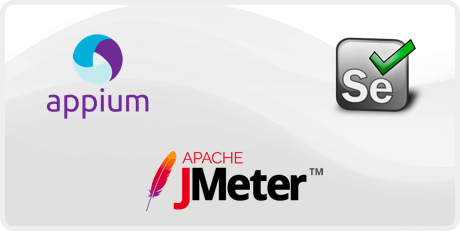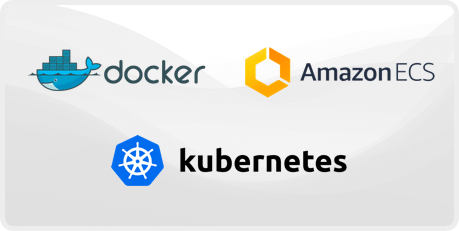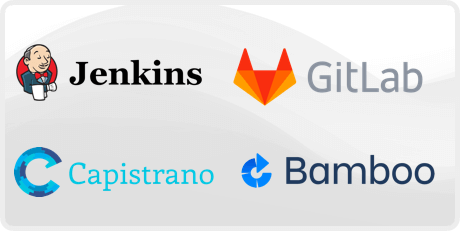Share your requirements and we'll get back to you with how we can help.
Thank you for submitting your request.
We will get back to you shortly.
Enabling DevOps Transformation in Enterprises
IT agility defines the success or failure of an organization in a world driven by technological innovation. As DevOps consultants, we enable businesses to adapt and stay nimble with cloud-native technology, automation, and continuous delivery models. While these technologies can be easier to adopt for start-ups, it requires a more concerted effort in traditional enterprise settings.
Traditional businesses function with historically isolated teams protecting conflicting interests (change vs stability) and hence lack the ability to respond to rapidly changing business environment. DevOps transformation aims to replace this siloed approach with a single value stream connecting customer, design, production, and delivery through incremental improvement. It calls for changes at three levels: organization structure, culture, and technology stack.
DevOps Consulting
Talk to our DevOps consultants to identify changes needed in your organization. Kickstart the transformation with a readiness assessment.
Identifying and Mapping Your Value Streams
Most enterprises recognize the need to accelerate development velocity to support innovation. They realize the need to change their age-old practices and processes in order to achieve agility without compromising quality, reliability, and security. What businesses fail to identify is how and where to begin. Our consultants help you overcome this obstacle.
With help from your teams and inputs from the company leadership, our DevOps architects gain an understanding of your processes and the activities at each stage. They identify steps that add value and those that do not. Such an as-is value stream mapping will provide an organized visualization of the key steps in your process and the improvements necessary to optimize it.
Improving the Flow Through Your Value Stream
When the current state of your value stream has been established, it is easier to identify wastes and ways to reduce or eliminate them in order to improve the flow through the stream. We can then proceed to design a future state map, which automates as much as possible and delivers completed software in less time with higher quality.
Many organizations use techniques such as Kanban to manage and optimize their workflows after undergoing a value stream mapping (VSM) activity. The workflow visualization can provide a unified and holistic view of the overall process and a clear perspective of how each team contributes to the finished product.
Steps to Improve the Flow Through a Software Development Value Stream
- Make work visible (e.g., using a Kanban board)
- Reduce or limit work in progress
- Decrease the number of handoffs between teams
- Automate builds, tests, security checks, and deployments
- Release in small batches
- Provide early feedback
Organizing Your Teams
Realigning your teams around common goals, processes, and tools may be necessary during DevOps transformation. Development and operations must function together as one agile team to deliver value. This can be achieved with cross-functional teams that are fully empowered and self-sufficient. These teams can be formed temporarily to work on time-boxed projects with resources pulled in from different departments. With fewer hand-offs and shared goals, such teams work efficiently.
A fully embedded operations team, where the systems engineer can code or the developer has deep infrastructure knowledge to deploy and scale the application is rarely feasible. Instead, you could go for a model based on close-knit collaboration between your Dev and Ops teams. Both teams should collaborate and share responsibilities from the initial planning phase to the continual monitoring of the production environment.
You could even opt to have a dedicated DevOps team providing shared services to address challenges such as version control, continuous integration, and deployment automation. This is a kind of functional organization and care must be taken to avoid its inherent pitfalls.
Sometimes, you may be able to retain your existing organizational structure (functional/divisional/matrix) with certain modifications. Our DevOps consultant will guide your choice considering available resources, the relationship between your teams, and the flexibility of your current organizational structure.
Regardless of the organizational model you may implement, these are some key team characteristics to keep in mind.
- Shared vision, objectives, plus a solution perspective
- Ability to deliver incremental value
- Quality and pride in workmanship
- Clear accountability and a flat structure
- Open communications and continuous improvement
Technology Stack for Your DevOps Transformation
In addition to choosing the right team and building a culture of open and honest collaboration, another vital step toward DevOps transformation is automating your builds, tests, deployments, infrastructure, and other processes where possible.
Continuous Integration (CI)

Integrating the work of your developers into a shared repository early and more frequently enables early detection of integration bugs that can be resolved faster. When small batch mergers are made a part of daily work, it enables frequent delivery of software. There are numerous version control tools that developers can use to commit frequent code changes to the main repository. The continuous integration server polls the version control system for code changes, retrieves the latest code, and builds it.
Automated Testing

With continuous integration in place, automated testing is implied. Each code commit can be integrated with a build script and verified by automated tests. If testing is not automated, your team will continue to experience slow release cycles despite the increase in development velocity.
Unit tests, acceptance tests, integration tests, and even non-functional tests, such as performance and security testing, can be automated. Unit and acceptance tests can be set up to run in parallel. We may automate non-functional tests using tools like JMeter, NeoLoad, and Browsera.
With some of the automated tests configured on the developer workstation itself, your developers will have even faster feedback on the quality of their work. For instance, Foodcritic can provide feedback to a Ruby developer on code structure and syntax while Sonarlint analyzes the Selenium tests written by the test automation engineer.
You just need to ensure the tests are reliable as false positives can create more problems than automated testing aims to solve. We often recommend clients to start small with a small suite of reliable automated tests and expand their coverage over time.
Infrastructure Setup

Just as you automate software builds, you should be able to automate the provisioning and operation of your environments (dev/test, staging, production). This can be achieved using modern provisioning and configuration management tools that allow you to programmatically set up environments and manage system configurations through code (Infrastructure as code).
For a consistent and reliable infrastructure that avoids configuration drift, you could choose the immutable infrastructure model where servers are never modified once deployed. Under such an approach, a new server with appropriate updates is provisioned to replace the existing one when change becomes necessary.
When infrastructure setup is written as code, you can use version control system and automated testing for environment provisioning and integrate it with the CI/CD pipeline used for application code. Tools, such as Foodcritic for Chef or puppet-lint for Puppet, can be used to analyze the code written to construct the environments. These and other security hardening checks can also be included in your automated test suite.
Containerization

Organizations may choose to combine infrastructure as code with containers. It allows for decoupling infrastructure requirements from the application environment.
Containers bundle elements of the operating system (language runtimes, libraries, system files) with the application. Changes to these elements can be made without any changes to the host system so that specific development environments need not be set up every time. Containers also make it easy to clone environments and are lightweight compared to virtual machines.
Deployment Pipeline

Once you have continuous integration and test automation in place, we can build your deployment pipeline. Every change is a release candidate in this pipeline. Each code change runs a build that creates a package ready to be deployed. Automated tests (unit tests, static code analysis, acceptance tests) are run to provide fast feedback to your developers. Packages that pass these tests (often run in parallel) are made available for the next series of tests (exploratory testing) and finally for deployment to production. If a change causes the build to fail, we can configure the deployment pipeline to pull the Andon cord to alert all users and allow no new changes to be integrated until the error is resolved or the commit is rolled back to restore the green build state of the pipeline.
Continuous Deployment (CD)
Your team can now push changes frequently, get fast feedback, and keep the codebase ready for confident deployments into production environment. With a mature continuous delivery setup, your codebase is ready to be deployed on demand and multiple times a day (green state). Thus, you are ready for frequent release of bug-free software.
Continuous deployment extends continuous delivery pipeline further to automate the actual deployment. At the last segment of the deployment pipeline, the codebase can be deployed automatically without human intervention. Such a system enables you to quickly roll out new features and gather user feedback.
Monitoring

With continuous integration, automated testing, and continuous deployment, DevOps methodology enables frequent code changes. This calls for comprehensive and real-time monitoring of your application code, environments, and orchestration technologies. Application performance monitoring tools such as New Relic can be used for continuous monitoring of applications in production environment. You can broaden the scope of continuous monitoring to staging, testing, and even development environments as your teams start to use production-like environments for dev and test.
Automated monitoring from the early stages of your DevOps pipeline will keep the pipeline flowing smoothly. While you monitor builds (track development milestones), automated tests, deployments, server health, and application logs, it is pivotal to gather this data at a central location to analyze and correlate. The derived metrics can be plotted as graphs or statistically analyzed to identify trends, detect anomalies, and generate alerts for outages.
Continuous Integration (CI)
Integrating the work of your developers into a shared repository early and more frequently enables early detection of integration bugs that can be resolved faster. When small batch mergers are made a part of daily work, it enables frequent delivery of software. There are numerous version control tools that developers can use to commit frequent code changes to the main repository. The continuous integration server polls the version control system for code changes, retrieves the latest code, and builds it.

Automated Testing
With continuous integration in place, automated testing is implied. Each code commit can be integrated with a build script and verified by automated tests. If testing is not automated, your team will continue to experience slow release cycles despite the increase in development velocity.
Unit tests, acceptance tests, integration tests, and even non-functional tests, such as performance and security testing, can be automated. Unit and acceptance tests can be set up to run in parallel. We may automate non-functional tests using tools like JMeter, NeoLoad, and Browsera.
With some of the automated tests configured on the developer workstation itself, your developers will have even faster feedback on the quality of their work. For instance, Foodcritic can provide feedback to a Ruby developer on code structure and syntax while Sonarlint analyzes the Selenium tests written by the test automation engineer.
You just need to ensure the tests are reliable as false positives can create more problems than automated testing aims to solve. We often recommend clients to start small with a small suite of reliable automated tests and expand their coverage over time.

Infrastructure Setup
Just as you automate software builds, you should be able to automate the provisioning and operation of your environments (dev/test, staging, production). This can be achieved using modern provisioning and configuration management tools that allow you to programmatically set up environments and manage system configurations through code (Infrastructure as code).
For a consistent and reliable infrastructure that avoids configuration drift, you could choose the immutable infrastructure model where servers are never modified once deployed. Under such an approach, a new server with appropriate updates is provisioned to replace the existing one when change becomes necessary.
When infrastructure setup is written as code, you can use version control system and automated testing for environment provisioning and integrate it with the CI/CD pipeline used for application code. Tools, such as Foodcritic for Chef or puppet-lint for Puppet, can be used to analyze the code written to construct the environments. These and other security hardening checks can also be included in your automated test suite.

Containerization
Organizations may choose to combine infrastructure as code with containers. It allows for decoupling infrastructure requirements from the application environment.
Containers bundle elements of the operating system (language runtimes, libraries, system files) with the application. Changes to these elements can be made without any changes to the host system so that specific development environments need not be set up every time. Containers also make it easy to clone environments and are lightweight compared to virtual machines.

Deployment Pipeline
Once you have continuous integration and test automation in place, we can build your deployment pipeline. Every change is a release candidate in this pipeline. Each code change runs a build that creates a package ready to be deployed. Automated tests (unit tests, static code analysis, acceptance tests) are run to provide fast feedback to your developers. Packages that pass these tests (often run in parallel) are made available for the next series of tests (exploratory testing) and finally for deployment to production. If a change causes the build to fail, we can configure the deployment pipeline to pull the Andon cord to alert all users and allow no new changes to be integrated until the error is resolved or the commit is rolled back to restore the green build state of the pipeline.

Continuous Deployment (CD)
Your team can now push changes frequently, get fast feedback, and keep the codebase ready for confident deployments into production environment. With a mature continuous delivery setup, your codebase is ready to be deployed on demand and multiple times a day (green state). Thus, you are ready for frequent release of bug-free software.
Continuous deployment extends continuous delivery pipeline further to automate the actual deployment. At the last segment of the deployment pipeline, the codebase can be deployed automatically without human intervention. Such a system enables you to quickly roll out new features and gather user feedback.
Monitoring
With continuous integration, automated testing, and continuous deployment, DevOps methodology enables frequent code changes. This calls for comprehensive and real-time monitoring of your application code, environments, and orchestration technologies. Application performance monitoring tools such as New Relic can be used for continuous monitoring of applications in production environment. You can broaden the scope of continuous monitoring to staging, testing, and even development environments as your teams start to use production-like environments for dev and test.
Automated monitoring from the early stages of your DevOps pipeline will keep the pipeline flowing smoothly. While you monitor builds (track development milestones), automated tests, deployments, server health, and application logs, it is pivotal to gather this data at a central location to analyze and correlate. The derived metrics can be plotted as graphs or statistically analyzed to identify trends, detect anomalies, and generate alerts for outages.

Release Patterns for a DevOps Implementation
As you gain the flexibility to deploy on demand, you can choose how quickly new features are released to customers. You can employ an environment-based release pattern implemented at the infrastructure level or an application-based pattern that can be implemented through the code.
Environment-based release patterns require little or no change to the application code. You can have multiple environments to deploy to but only one will receive live traffic. By deploying code to a non-live environment, both risk and deployment lead time can be reduced considerably.
Blue-Green
Deployment
Two identical production environments (blue and green) but only one (say, blue) serves live traffic. Change is tested and verified in the idle environment (green), which is then switched to handle live traffic. Post-deployment, blue becomes the new staging while green serves live traffic. Simple, easy, one-step deployment with zero downtime. Rapid way to rollback. Switch traffic back to blue if anything goes wrong.
Canary
Deployment
Further reduces the risk of introducing new changes when compared to the blue-green system. Change is made available to a subset of users (a random sample or selection based on geography/ demographic). Gradually release the new version to all users and decommission the old. The incremental rollout enables capacity testing of the new version. Users can be rerouted to the old version if a problem is detected.
Cluster
Immune System
Automated deployment and rollback process, which is an extension of canary deployment. Change is incrementally deployed; cluster and business metrics are monitored in real time. If SLAs are not met, the process automatically reverts the change. Less time needed to detect and respond to performance degradation. Further deployments are locked until the problem is investigated and resolved.
Blue-Green Deployment
Two identical production environments (blue and green) but only one (say, blue) serves live traffic. Change is tested and verified in the idle environment (green), which is then switched to handle live traffic. Post-deployment, blue becomes the new staging while green serves live traffic. Simple, easy, one-step deployment with zero downtime. Rapid way to rollback. Switch traffic back to blue if anything goes wrong.
Canary Deployment
Further reduces the risk of introducing new changes when compared to the blue-green system. Change is made available to a subset of users (a random sample or selection based on geography/ demographic). Gradually release the new version to all users and decommission the old. The incremental rollout enables capacity testing of the new version. Users can be rerouted to the old version if a problem is detected.
Cluster Immune System
Automated deployment and rollback process, which is an extension of canary deployment. Change is incrementally deployed; cluster and business metrics are monitored in real time. If SLAs are not met, the process automatically reverts the change. Less time needed to detect and respond to performance degradation. Further deployments are locked until the problem is investigated and resolved.
Application-based release patterns allow you to selectively expose application features through small configuration changes providing greater flexibility. As such a release pattern needs code changes, you will need development support for its implementation.
Feature Toggles
Enable or disable features without deploying code to production. Control the features available to a segment of users. Change the toggle settings to quickly roll back a feature that creates problems. Downgrade performance with grace. Reduce the number of features delivered to serve more users and avoid total service failure.
Dark Launches
Extend feature toggles with dark launch. Deploy features to production without making them available to users. Safely test large and risky changes with production-like loads. Progressively roll out a feature to small segments of users to minimize the number affected in case of a revert.
Feature Toggles
Enable or disable features without deploying code to production. Control the features available to a segment of users. Change the toggle settings to quickly roll back a feature that creates problems. Downgrade performance with grace. Reduce the number of features delivered to serve more users and avoid total service failure.
Dark Launches
Extend feature toggles with dark launch. Deploy features to production without making them available to users. Safely test large and risky changes with production-like loads. Progressively roll out a feature to small segments of users to minimize the number affected in case of a revert.
Software Architecture for DevOps Model
Software architecture plays an important role in the accomplishment of your organization’s DevOps goals. An architecture that allows for small, independently productive teams is always desired. Service-oriented architectures with loosely coupled services enable teams to make small changes with low risks improving productivity, testability, and security.
The modular microservice architecture allows for independent testing, deployment, and scaling as compared to purely monolithic structures that often result in coordination overheads, long build times, and poor scaling. Practices such as the strangler application can be adopted to slowly replace the monolithic system with a more service-oriented architecture, if necessary.
DevOps as a Service - Enable Your Transition
Enable your teams to smoothly embrace the new model. Our consultants and DevOps architects can support the transition from beginning to end by assessing, implementing, and maintaining your infrastructure and CI/CD pipelines. You may even choose to use our DevOps consulting service for any of the following:
- CI/CD pipeline implementation
- Infrastructure redesign/Infrastructure as code setup
- Configuration management
- Server orchestration
- Containerization
- Release management
- Cloud migration (AWS, Azure, GCP)
- Microservice architecture
The path to DevOps is one of progressive maturity with frequent evaluations and continuous improvements to move toward the ideal state. Regardless of the maturity level of your organization, our DevOps consulting and implementation services can help you progress. Schedule a discussion with our DevOps engineers today.
